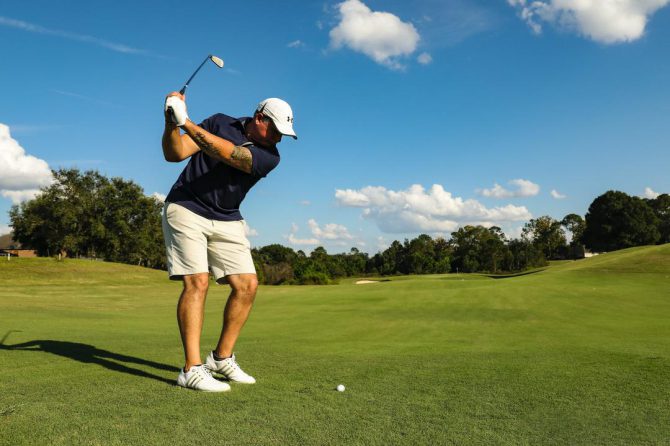Mastering the Golf Swing Follow-Through: Precision and Control
The follow-through in golf is a crucial element that greatly impacts the accuracy and consistency of a player’s swing. This article delves into the biomechanical principles that can help golfers refine their follow-through, drawing on recent research to highlight effective techniques for improved ball striking. By examining how body mechanics, clubface orientation, and weight distribution interact, golfers can gain insights to elevate their performance on the course.
Understanding Biomechanics in the Follow-Through
Pelvic Movement and Hip Dynamics
- Power during the downswing is generated as hips rotate and extend, propelling the clubhead through impact.
- In the follow-through phase, continued pelvic rotation allows for a downward arc of the club’s path.
- This motion not only sustains clubhead speed but also encourages a slight draw on the ball, enhancing both accuracy and control over its flight.
Thoracic Spine Engagement
- The thoracic spine plays an essential role during both downswing and follow-through phases.
- As players transition into their follow-through, spinal rotation unwinds in reverse direction.
- This movement creates centrifugal force that keeps the clubhead on a smooth trajectory while ensuring it finishes parallel to your target line.
Wrist Positioning
- A firm wrist at impact maximizes speed; however, during follow-through, extending wrists allows for controlled lag behind hands.
- This “bowing” effect aids in managing release timing of the clubhead—crucial for achieving square contact with minimal hooks or slices.
Enhancing Distance Through Controlled Release
A well-timed release of grip pressure during your swing’s follow-through is vital for maximizing distance. Gradually releasing grip at just the right moment helps maintain rhythm while optimizing swing speed.
Timing is critical; an early release may lead to weak shots while delaying it could result in unwanted hooks or slices. The ideal moment occurs when your clubshaft aligns parallel to ground level with fully extended wrists—allowing gradual grip relaxation as you accelerate through impact.
Grip pressure also plays a significant role; maintaining a relaxed yet firm hold throughout ensures stability. As you transition into your follow-through phase by easing up on grip pressure gradually allows natural swing dynamics to take over—resulting in smoother swings with consistent ball contact.
Rotational Dynamics During Follow-Through
The complexity of rotational dynamics significantly influences how effectively golfers can optimize their swings:
- Clubhead Speed: The velocity at which your clubhead strikes impacts shot distance directly. Continuous arm and shoulder rotation post-impact transfers energy efficiently from body movements into powerful shots.
- Clubface Orientation: Proper alignment upon impact remains crucial; extending wrists correctly ensures that upon release—the face remains square or slightly closed—yielding desired trajectory and spin characteristics necessary for height/distance control.
- Body Rotation: Effective hip/shoulder movement facilitates optimal energy transfer from lower body through upper body enabling timely releases leading towards consistent powerful outcomes throughout each shot cycle.
| Key Elements Influencing Clubhead Release |
| —————————————— |
| Rotational Dynamics |
| Clubhead Speed |
| Clubface Alignment |
| Body Rotation |
Achieving Consistency in Your Follow-Through
Consistency within this phase is paramount for achieving reliable accuracy:
- Stable Head Position: Keeping your head steady throughout all stages—including after impact—prevents misalignment which often leads toward erratic results.
- Maintaining Spine Angle: Retaining proper spine angle fosters balance essential not only during execution but also contributes positively towards overall striking consistency across various conditions encountered out on course terrain!
- Balanced Finish Post-Swing: Conclude each swing maintaining an athletic stance where weight evenly distributes between legs ensuring straightened posture enhances stability further aiding precision efforts moving forward!
Advanced Techniques for Symmetry & Flow Enhancement
To refine swinging capabilities further consider implementing advanced strategies aimed at promoting symmetry alongside fluidity:
Mirror Practice
Utilize full-length mirrors mimicking swings from backswing through finish provides visual feedback revealing imbalances needing correction fostering synchronized motions overall!
Tempo Drills
Incorporate rhythmic tools like metronomes establishing consistent pacing prevents rushed actions allowing ample time dedicated towards executing precise movements seamlessly transitioning between phases effortlessly!
Core Strengthening Exercises
Focus strengthening core muscles improves awareness regarding posture aligning spines appropriately promotes better balance ultimately enhancing power transfer resulting smoother transitions supporting enhanced accuracy/distance control achieved consistently over time!
By thoroughly exploring these biomechanical principles related specifically toward golf’s pivotal aspect—the follow-through—it becomes evident how mastering such techniques empowers players seeking greater precision/control within every stroke taken! Continued practice coupled alongside ongoing research will undoubtedly yield fruitful improvements elevating one’s game significantly higher than before!

Unlocking Your Best Swing: Mastering the Follow-Through for Precision and Control
Meta Title: Mastering Your Golf Swing Follow-Through for Precision and Control
Meta Description: Discover essential techniques and tips to optimize your golf swing follow-through, enhancing accuracy and consistency on the course.
Understanding the Follow-Through
The follow-through is a critical phase of the golf swing that plays a vital role in determining the outcome of the shot. It’s not merely a concluding motion; instead, it serves as a reflection of the entire swing mechanics. A well-executed follow-through promotes balance, ensures proper body alignment, and provides a smoother transit of energy, ultimately leading to improved accuracy.
Key Biomechanical Principles
- Body Alignment: Proper body alignment throughout the follow-through ensures that your swing path remains true, keeping your shots on target.
- Weight Transfer: Understanding the shift of weight from your back foot to your front foot during the follow-through is crucial for maintaining balance and control.
- Hip and Shoulder Rotation: The synchronized rotation of the hips and shoulders allows for a full release of energy, enhancing the distance and accuracy of your shots.
Benefits of an Optimized Follow-Through
- Improved Accuracy: A refined follow-through aligns your body for accurate shot placement.
- Enhanced Control: A stable finish allows for better control over your ball’s trajectory.
- Increased Power: An effective follow-through maximizes the energy transferred from your swing, resulting in longer shots.
Practical Tips for Mastering Your Follow-Through
1. Focus on Balance
To achieve an effective follow-through, maintain your balance through the shot. Here are some tips to improve your balance:
- Practice One-Legged Swings: This drill can help you learn to control your body’s movement during the follow-through.
- Finish in Your Stance: Aim to complete your swing with your weight over your front foot, signifying a balanced follow-through.
2. Visualize the Finish Position
Envisioning where you want to end up can give you a mental target to aim for. Consider the following:
- Use Video Analysis: Record your swing to analyze your follow-through and make necessary adjustments.
- Set Specific Goals: Aim to finish your swing with your chest facing the target, hands high above the shoulder.
3. Incorporate Strength Exercises
Building core strength can greatly enhance your follow-through technique. Consider the following exercises:
- Planks: Improve core stability, which supports your swing mechanics.
- Rotational Exercises: Incorporate medicine ball twists to simulate the hip and shoulder rotation of your swing.
4. Utilize the Right Equipment
Choosing the right club is essential to facilitate an optimal follow-through. Pay attention to:
- Club Length and Grip Size: Ensure you are comfortable and in control of your club throughout your swing.
- Equipment Fit: Consider getting professionally fitted for clubs that match your swing style and strength.
Case Studies: Successful Follow-Through Techniques
Case Study 1: The Professional Golfer’s Follow-Through
Many professional golfers have perfected their follow-through to optimize their game. For instance, PGA Tour players often display a “High Finish”—this not only looks striking but also reinforces a strong, accurate shot. The key components observed in their technique include:
| Golfer | Technique Highlights | Result |
|—————–|—————————|————————|
| Rory McIlroy | Full rotation, high hands | Consistently long drives|
| Jordan Spieth | Stable finish, balance | Precise short game shots|
Case Study 2: Amateur Golfer Improvement
An amateur player focusing on their follow-through can yield dramatic improvements. By working on staying balanced and ensuring proper rotation, many golfers report:
- Reduced Slice: A refined follow-through helps eliminate common issues like slicing the ball.
- Enhanced Distance: A more powerful finish translates to greater driving distance and more effective iron shots.
First-Hand Experience: Personal Journey to Mastery
As an enthusiastic golfer, my journey to refining the follow-through began when I noticed my shots often veering off course. After investigating various techniques and applying the tips mentioned, I observed significant progress in my game.
One of the most transformative exercises was practicing my follow-through in front of a mirror, allowing me to visualize the desired finish. This not only enhanced my confidence but also reinforced proper body mechanics.
Additionally, I enlisted the help of a coach who emphasized the importance of balance and alignment. Through consistent practice and dedication, my follow-through improved, leading to more consistent shots and lower scores.
Conclusion
Mastering the golf swing follow-through is essential for achieving enhanced accuracy and control on the course. By focusing on balance, incorporating strength training, and understanding the biomechanical principles at play, golfers can unlock their potential.
With diligence and practice, you will witness improved performance and newfound confidence in your game. Now, step out onto the green and apply these techniques to elevate your golfing skills!




